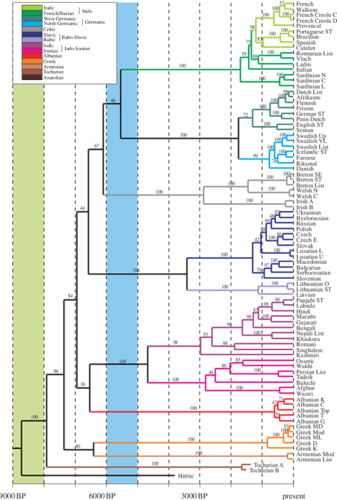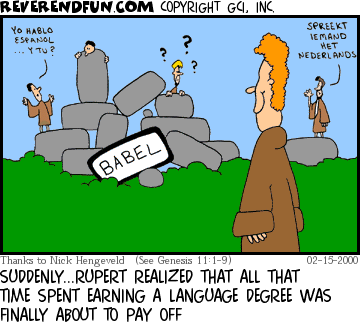This is for Sealkin, I wasn’t thinking last night after 11 hours of writing. I do have something that makes the basic claim of Babel that we spoke one language true. Here it is
This is in answer to Sealkin’s question last night. After writing for 11 hours yesterday, I wasn’t thinking in my answer. Yes, I have something that makes at least part of the Babel story valid–we seem to once had a common language.
Many Christians and non-christians alike have questioned
the reality of the Tower of Babel or ignored it altogether. Indeed, other
than in young-earth literature it is difficult to find a reference to this event. Andrew White, in A History of
the Warfare between Science and Theology in Christendom, attacks the very idea of the story. Davis
Young omits it in his book, The Biblical Flood. Bernard Ramm in The Christian View of Science and
Scripture makes only the slightest reference to it. Obviously, this story causes some concern or
embarrassment among Christian apologists who steer far from it.
However, since this event is in the Bible one must face the question of whether it is a real event or if it is merely an allegory. During the past decade some evidence has been developed which does support one aspect of the story–the contention that the entire human race once spoke the same language. Merrit Ruhlen (not a creationist) points out much of this data in his book, Merritt Ruhlen, The Origin of Language, (New York: John Wiley and Sons, 1994). These are from some posts I made to the ASA listserv and TheologyWeb:
Within the past decade some linguists have found evidence of a former unity among languages. Not all linguists accept this data, but Joseph Greenberg (one of the foremost linguists of this century who produced the classification of African languages now in use) and Merritt Ruhlen have argued for much wider connections among the languages.
First, I would also point people to my article Morton, G. R. (2002) “Language at the Dawn of Humanity,” Perspectives on Science and Christian Faith, 54(2002):3:193-194. This discusses some work presented at the 2001 meeting of the American Society of Human Genetics, There are two click languages Sandawe and Hadza, which are spoken by two groups which were believed to be related, although for years linguists had noted that the languages themselves seem very very distant in spite of sharing the same characteristic of having click sounds included in the language. Alec Knight, Joanna Mountain and colleagues analyzed the Y chromosomes of the two groups and found that these two groups were genetically the most distant pair of populations on earth. In other words, their last common ancestor was as long ago as 100,000 years. The abstract says:
A. Knight1, P.A. Underhill2, H.M. Mortensen, A.A. Lin, D. Louis, M. Ruhlen, J.L. Mountain,“Y
chromosome and mtDNA variation in linguistically diverse peoples of Tanzania: Ancient roots and
ancient clicks”
"We analyzed genetic variation in 122 “unrelated” individuals from the vicinity of Lake Eyasi in north-central Tanzania, to recover aspects of population history and human evolution. Representatives of the four linguistic phyla of Africa were studied, including 50 Hadzabe (or Hadza) foragers. We present a Y chromosome phylogeny derived from unique event polymorphisms (UEPs). We also present Y chromosome microsatellite variation within UEP-defined clades, mitochondrial DNA (mtDNA) fragment polymorphisms, and nucleotide sequences of both mtDNA control region hypervariable segments. When compared to other African population data, our results reveal elements of prehistory relevant to the evolution of anatomically modern humans, including migration, gene flow, and language. We were able to distinguish recent gene flow from ancient demographic signatures. Hadzabe are strongly differentiated from other groups, have high genetic diversity, and exhibit comparatively great genetic distance from the !Kung of southern Africa, suggesting great antiquity for click (Khoisan) languages.
end of abstract
This was also reported in Science News, Oct. 27,2001.
What they concluded was that these two groups of people shared a common genetic and linguistic history 100,000 years ago but went their separate ways in both areas. The data seems to indicate that one of the earliest human languages belongs to the click family (Khoisan family).
Now that data demonstrates the likelihood of language at least 100,000 years ago, not the 60 kyr of Hugh Ross’s view. And the anatomical data seems to indicate that mankind was speaking at least 3 times longer. Theology and apologetics simply must deal with this issue. But are there other connections?
Linguistics
One of the ways such connections are found is in the same sound being used in different languages and language families (cognates). The words that appear most stable across language family boundaries are those which are very essential or personal or relational. The data listed below, while not proving the Tower of Babel story does support the original contention that mankind did speak one language which is one of the claims of the Bible.
I will discuss only two words, water and finger(aqwa and tik), but there are lots of other words that unite the world’s languages.
These include (Ruhlen p. 105)
sound meaning
papa father
mama mother kaka brother/uncle
ku who
ma what (ma is used in Mandarin as a question indicator)
pal two
akwa water
tik finger
kanV arm
boko arm
bunku knee
sum hair
putV vulva
cuna nose smell
KamV squeeze
parV fly
(the capital V represents a vowel whose original pronunciation is unknown)
Ruhlen states:
" Another striking resemblance among the world’s language families is a word whose original meaning was probably ‘finger’ (though it has evolved to ‘one’ and ‘hand’[=‘fingers’] in many languages), and whose originalform was something like tik. I first became aware of the widespread nature of this root at a public lecture that Greenberg gave at Stanford in 1977, in which he mentioned three roots that were widely distributed around the world: tik ‘finger,’ pal ‘two’ (which we will look at in the following section), and par ‘to fly.’ As you no doubt noticed in your examination of Table 10, no less than eight of the twelve families show traces of tik ‘finger,one,’ namely, Nilo-Saharan (B), Niger-Kordofanian (C), Afro-Asiatic (D), Eurasiatic (G), Dene-Caucasian (H), Austric (I), Indo-Pacific (J) and Amerind (L) " ~Merritt Ruhlen, The Origin of Language, (New York: John Wiley and Sons, 1994), p. 115
Linguistic symbols and evolution of sounds
? sounds like tt’s in bottle when pronouced like by a cockney in London. I need to point out the sound changes that linguists have found
d->z
g->k
k->g
p->f->h
k->x->h
k->?
d->z
t->d
t->th->s
i->y
u->w
Linguists look at sounds and how they change and then compare cognates from different languages looking for a pattern. This is illustrated by the following data regarding African languages: You can scroll the boxes below to see all the words
Language sound meaning
Fur tek one
Maba tek (tuk) one
Nera dekk-u one
Dinka tok one
Berta diikoni one
Mangetu t'e one
Kwama seek-o one t changed to s
Bari to one
Jur tok one
Twampa de? one
Komo de one
Ruhlen states,
"In 1972 the American linguist Edgar Gregersen presented substantial evidence connecting two of Greenberg's four African families, Nilo-Saharan and Niger-Kordofanian. One of the pieces of evidence he offered was Niger-Kordofanian forms that appeared cognate with the Nilo-Saharan forms just cited." ~Merritt Ruhlen, The Origin of Language, (New York: John Wiley and Sons, 1994), p. 115-116
**Tik, Finger/One**
**Niger-Kordofanian family**
Fulup qsik~sex finger (~ separates variant pronunciations)
Nalu te finger
Gur dike one
Gwa dogbo one
Fon dokpa one
Ewe deka one
Tonga tiho finger
Chopi t'ho finger
Ki-Bira zika finger
Ba-Kiokwa zigu finger
**Afro-Asiatic family of North Africa**
Oromo toko one
West Gurage tegu only one
Yaaku tegei hand
Saho ti one
Bilin tu one
Tsamai dokko one
Nefusa tukod finger
Hausa tak only one
Gisiga tekoy one
Gidder te-teka one
Logone tku first
**Eurasiatic family**
**Indoeuropean branch**
Indoeuropean root deik
Latin dig-itus finger
Latin indeks forefinger
English toe toe
Old English tahe toe
Latin Decem 10
**Uralic branch**
Votyak odik one
Zyrian otik one
**Turkic branch**
Chuvash tek only, just
Uighur tek only merely
Chagatai tek only, single
Turkish tek only
Turkish teken one by one
Korean tayki one, thing
Old Korean tek 10
Ainu tek hand
Ainu atiki five
Japanese te hand
Chuckchi-
Kamchatkan itygin paw-foot
**Eskimo-Aleut**
Upik tik-iq index finger
Inupiaq tik-iq index finger
Inupiaq Tikkuagpaa he points to it
Attu tik-laq middle finger
Attu atgu finger
Attu tagataq one
**Dene-Caucasian**
Rai tik(-pu) one
Nung thi one
Tibetan (g-)tsig one
**Yeniseian branch**
Ket tek finger
Punpokol tok finger
Kott tog-an finger
**Na-Dene branch**
Haida ta with the fingers
Tlingit t-eeq finger
Tlingit Tek one
Eyak tikhi one
Sarsi tlik one
Kutchin (i-)Tag one
Hupa ta? One
Navajo ta? One
**Austric family**
**Austroasiatic branch**
Kharia ti? Hand
Riang ti? Hand
Wa tai? Hand
Khmer tai hand
Vietnamese tay hand
**Daic branch**
Li dlian finger
Northern Li tlean,then finger
Loi then,cian finger
Tasmanian motook forefinger
SE tasmanian togue hand
Boven Mbian tek fingernail
Digul tuk fingernail
*Amerind languages**
**North American Amerind Family**
Nootka taka only
Mohawk tsi?er Finger
Sierra Miwok tika? Index finger
Wintun tiq-eles ten
Nisenan tok- hand
Mixe to?k, tuk one
Sayula tu?k one
Tzeltal tukal alone
Quiche tik'ex carry in the hand
Karok tik finger,hand
Achumawi wa-tuci finger
Washo tsek finger
Yana 'tgi- alone
East Pomo bi'yatsukai finger
Arraarra teeh'k hand
Pehtsik tiki-vash hand
Akwa'ala asit-dek one
Nahua tiikia?a one
Pima bajo cic one
Mazatec cika?a alone
Tarahumara sika hand
Mangue tike one
**South America Amerind family**
Chibcha ytiquyn finger
Chibcha Acik by ones
Borunca etsik one
Guatuso dooki one
Shiriana ithak hand
Ulua tinka-mak finger
Paez teec one
Cahuapana itekla finger,hand
Jebero itokla finger,hand
Qawashqar takso one
Siona tekua one
Siona teg-li five
Canichana eutixle finger
Yupua di(x)ka arm
Uasona dikaga arm
Upano tikitik one
Aguaruna tikij one
Murato tici hand
Uru ti one
Chipaya zek one
Itene taka one
Guamo dixi finger
Katembri tika toe
Yuracare tece thumb
Kukura tikua finger
Accaqwai tigina one
Ocaina dikabu arm
Mataco otejji one
agnani etegueno finger
Sensi (nawis)-tikoe one(finger)
Cavinena eme-toko hand
Botocudo (po-)cik one(finger)
Botocudo jik alone
~Merritt Ruhlen, The Origin of Language, (New York: John Wiley and Sons,
1994), p.115-119
I would add the example from the Sino-Tibetan family, Mandarin in which under the rule that d->z, the word for point is zhichu and the word for first is diyi.
Ruhlen presents a lot of data on three of the words which indicate a former connection. The word I am going to relate is water. The same sound is found over the world representing either water, or activities in and on water, including drinking, lakes, rivers, creeks etc.
Aq’wa ‘water’
Everyone has used the root ‘aqua’ as in ‘aquamarine’ and aquarium in Spanish the term is agua. In Latin aqua means water. There appears to be a root akwa or aqua which appears over and over in language family after language family with this sound associated with water, river/drink etc. I must emphasize that the table below is phonetic not proper spelling. The phonetic sounds are as follows x=ks or qs, the symbols ? , ) etc are my best representations of the phonetic symbols used in Ruhlen’s book. There is a difference between a single ) and a () pair, the pair represents the sound quality of the consonant.
Ruhlen postulates that the original word for water was aqwa. Some languages lost the first part and the word became qwa or kua and some lost the last part and the word became aq or ak. Some languages added parts. K’s changed to g’s or x’s according to normal rules of linguistic change. One could postulate that the word water came from a variation on the Ainu word for water Wakka, which then became watta or something like that. Anyway, here is some of the evidence for an originally single language among humans. Not all of the words make the case to this non-linguist, but there is enough similarity to make me take notice of what Ruhlen is saying. many of the words listed below have the q, k or ks sound in them. These sounds are made similarly by our mouths.
**Afro-Asiatic family**
language sound meaning
Janjero akka water
Kaffa aco water
Mocha ac'o water
Gofa hacca water
Shinasha ac'c'o water
Badditu wat'e water
Agaw aq water
biln ?aq water
Xamir aq(w) a drops of water
Quara axu water
Avia axu water
Damot ago water
Hadiyya wo?o water
Tamboaro waha water
Sidamo waho water
Iraqw aha drink
**Khoisan family of southern Africa**
!O !Kung kau rain
!Kung k''a drink
!Kung kau rain
!Naron k''a drink
|Kam-ka !ke k''wa drink
|Kam-ka !kekau rain
||Ng!Ke k''a drink
||Ng!Ke kau to rain
Batwa k''a drink
|Auni k''a drink
Masarwa k''a drink
|Nu||en k''a drink
**Nilo-Saharan Family**
Fur k)I rain
Nyimang kwe water
So kwe? Water
Ik cue water
Mangbetu equo water
Berta k)I rain, cloud
Kwama uuku water
Anej agu-d cloud
**Indo European Family**
Latin ak(w)a water
Hittite eku water
Luwian aku water
Palaic ahu drink
Italian akkwa drink
Provencal aiga water
Catalan aigwa water
Spanish agwa water
Portuguese aqwa water
Rumanian ape water
Sardinian abba water
Germanic ahwa river old Germanic manuscripts-modern German lost root
Tocharian yok drink
**Eurasiatic Family**
Ainu Wakka water
Ainu ku drink
Japanese aka bilge water
**Dene-Caucasian Family**
Chechen aq suckle
Burushaski hagum wet
Newari kwo river
Khaling ku water
Kachin k(h)u water
**Indo Pacific family**
Awyu okho water/river
syiagha okho water
Yareba ogo water
Yonggom oq water
Ninggirum ok water
**Amerind--native American**
Yurok -'k(w) suffix indicating movement on water
Quileute kwaya water
Kwakwala yax thin liquid
Bella Bella yug(w)a rain
Snohomish q(w)a? water
Squamish q(w)u water
Squamish q(rw)et wet
Nbisqualli ko water
Nbisqualli okokwa drink
Lkungen kwa water
Lkungen q(w)aq(w)a? water
Twana q)? water
Twana yeq(rw) wash
Shuswap kwo water
Caddo koko water
Caddo yoyakka drink
Wichita kik'a drink
Penutian branch
Nass ak(j)-s water
Twsimshian aks drink
Tsimshian yaks wash
Takema ug(w) drink
Siuslaw inq'aa river
Nez Perce k'u drink
Molale ?uquns water
Klamath joq' wash
N. Sahaptin -tkwa go in water
Wintun wak'ai creek
Wintun yuqa? Wash
Rumsien uk drink
Yokuts ?ukun drink
Lake Miwok kiik water
Saclan kiko water
Miwok kiky water
Zuni k'a water
Zuni k'I become wet
Yuki uk' water
Chitmacha ?ak- water
Atakapa ak water
Chickasaw oka? Water
Hitchiti uki water
Tetontepec uu?k drink
Zoque ?uhk drink
Yucatec uk' be thirsty
Yucatec yok-ha river
Kekchi u?ka drink
Hokan branch
Chimariko aqa water
Kashaya ?ahq(h)a water
Kashaya q'o drink
North Pomo ?ahk(h)a water
North Pomo k'o drink
SE Pomo xa water
S. Pomo ?ahk(h)a water
East Pomo xak(h) wet
Shasta ?atta water
Washo asa water
Karok ?as water
Esselen asa(-nax) water
Chumash aho water
Seri ?ax water
Seri Kiihk wet
Yuma axa? Water
Mohave aha water
Yavapai ?aha? water
Diegueno ?axa water
Quinigua kwa water
Tonkawa ?ax water
Comecrudo ax water
Tequistlatec l-axa? Water
Central Amerind branch
Otomi nk'a wet
Cuicatec ku?u drink
Tewa pokwin lake
Tewa kwan rain
South America Amerind
Chibchan-Paezan branch
Shiriana koa drink
Chimila uk drink
Binticua agan drink
Allentiac aka water
Andean branc Amerind
Iquito aqua water
Quechua yaku water
Quechua hoq'o get wet
Aymara oqo swallow
Mapudungu ko water
Genneken iagup water
Yamana aku lake
Macro-Tucanoan brach
Cubeo oko water
Bahukiwa oko water
Bahukiwa uku-mi he is drinking
Bahukiwa okobo rain
Tucano axko water
Erulia oxko water rain
Barasano oko water
Wanana ko water
Yahuna okoa rain
Auake okoa water river
Equatorial branch
Esmeralda kebi-axa let's drink
Ayore oxi? Drink
Kabishana aku water
Amniape aku water
Wayoro uru water
Mekens iki water
Guarani aki wet
Guarani I?u drink
Kamayura ?akim wet
Kamayura I?u drink
Quitemo ako water
Uaraicu waka wash
Terena oko rain
Chipaya ax wash
Guana uko rain
Apurina iaka wet
Amarakaeri iyako lake
Macro-Carib branch
Witoto hoko wash
Yagua Xa water
Taulipang ai?ku wet
Macusi u-wuku my drink
Macusi Aiku wet
Waiwai woku drink
Macro-Panoan branch
Lule uk drink
Guachi euak water
Caduveo yakip(a) drink
Suhin I-yoke drink
Mayoruna waka water
Mayoruna oakanu drink
Culino Yaku water
Culino waka river
Amahuaco wakum water
Amahuaco aiyaki drink
Nocoman wakoja river
Huarayo hakua wash
Cavinena igi drink
Macro-Ge branch
Bororo ku drink
Koraveka ako drink
Fulnio waka lake
Caraja axu lake
Kamakan kwa drink
Palmas goi water
Apucarana (n)goyo water
Delbergia ng)yo water
Apinage inko water river
Crengez ko water
Cayapo ngo water
Cayapo ikon drink
Chavante ko water
Cherente ko water
Chicriaba ku water
Aponegicran waiko drink
Suya ikone drink
~Merritt Ruhlen, The Origin of Language, (New York: John Wiley and Sons, 1994), p. 107-115
I would add the word from the Sino-Tibetan language, Mandarin, Kou ke which means thirst.
One other late edition here is that research reported July, 2004 noted that the word papa occurred in 700 out of 1000 languages which the authors studied. These 700 languages were from all different language families. In Mandarin, Baba means father. see News articles and features | New Scientist
So, I would say, that there very well may be linguistic evidence of a common root for these words throughout the world’s language. This is consistent with the Biblical assertion that humanity once spoke a common language. That being said, the thing wrong with young-earth views of this is that they place Babel far too late in history.
I don’t believe that this event was experienced by all the world’s population. Nothing really requires that view, that I can see. It is interesting, though, how widespread the sounds are.
When would I place the Babel event? I would guess between 100,000 and 200,000 years ago, before the second wave out of Africa. This second wave largely replaced the scattered older peoples like Denisovians, Neandrthals and archaic Homo sapiens. I think we speak languages from this second wave but they were split up.
While we may never find a site for Babel, we do have evidence of its primary claim that all humanity once spoke a single language.



